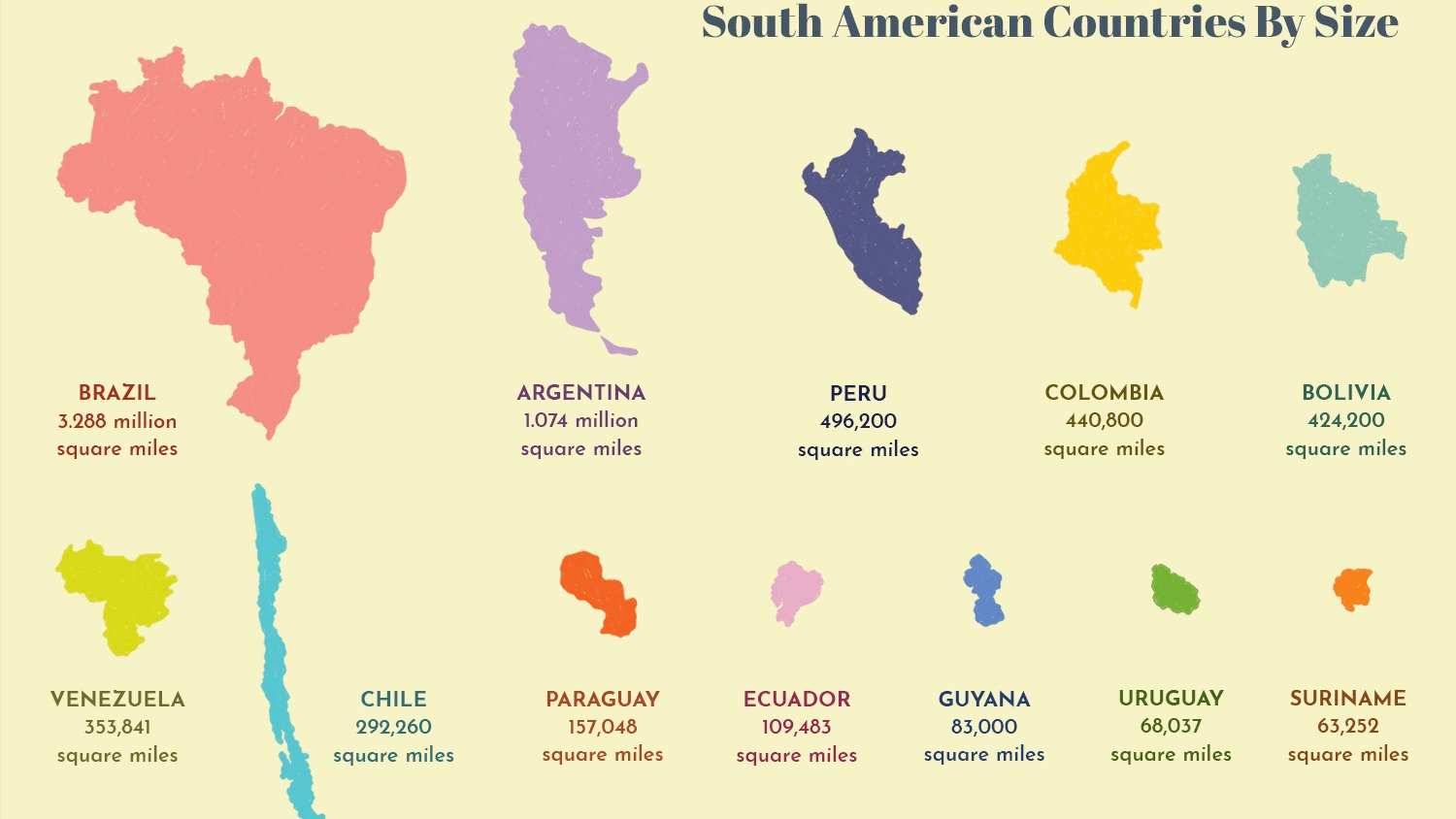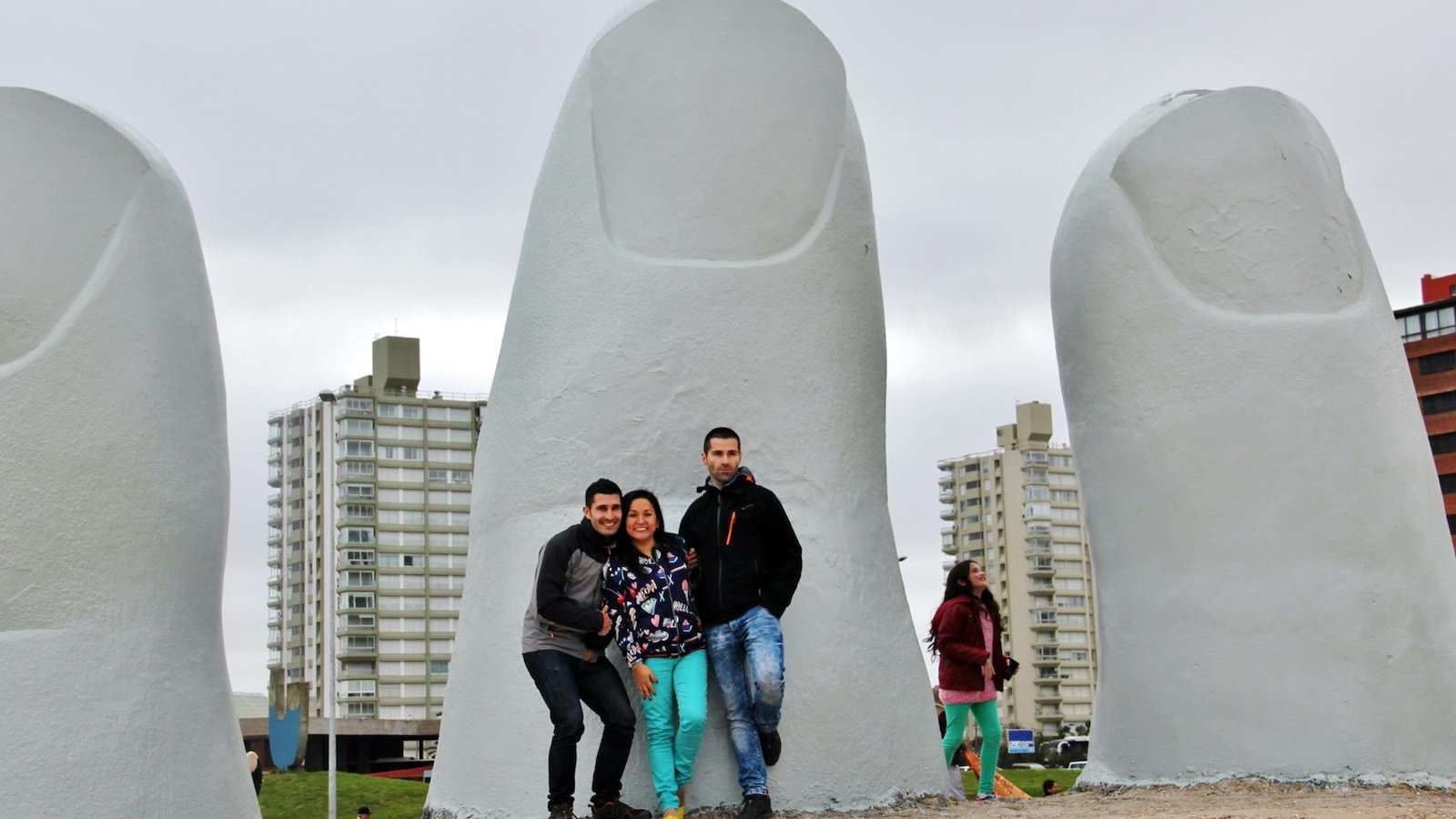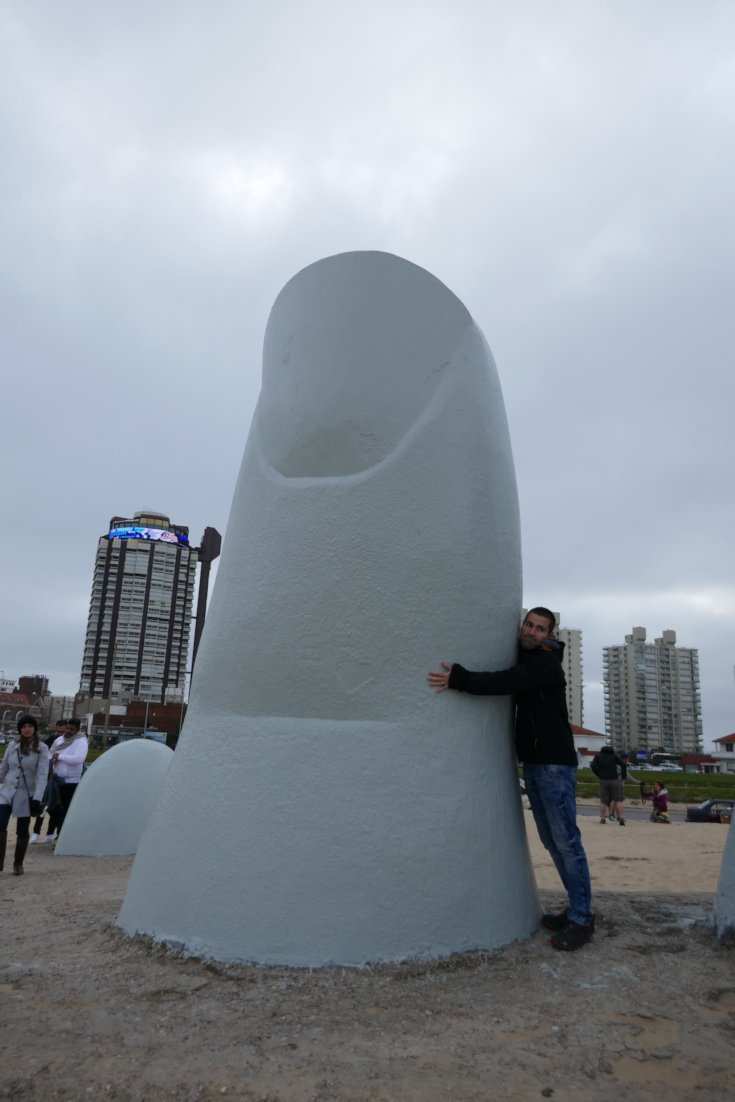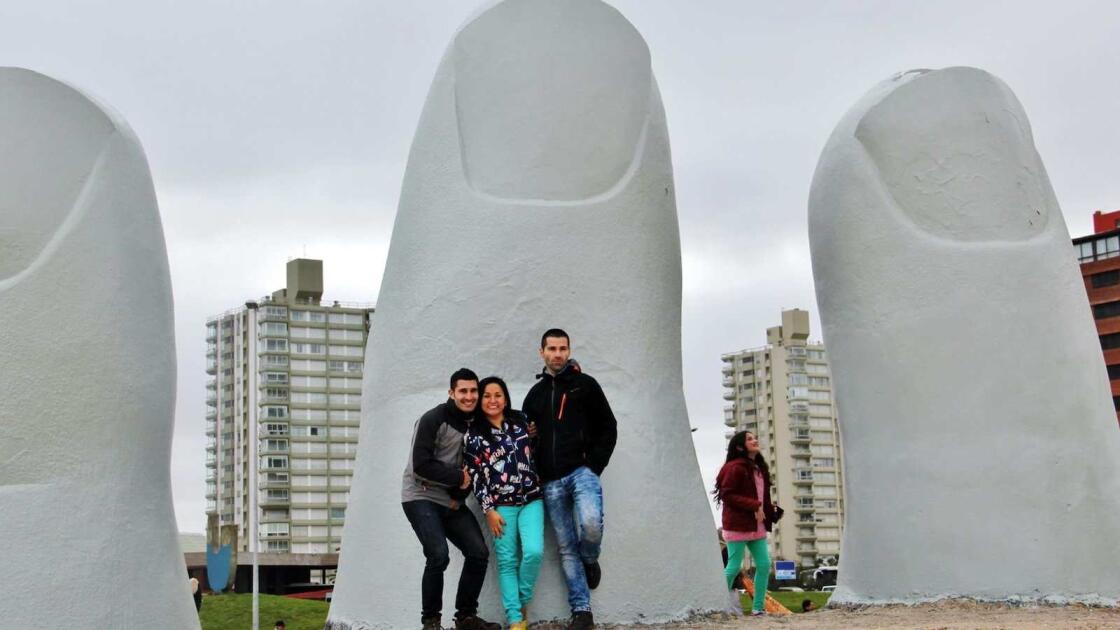Here are our favorite interesting facts about Uruguay that we discovered during our big trip here to inspire you to visit this underrated South American country.
Sweet, chilled little Uruguay, tucked away so harmlessly between Brazil and Argentina, causing no harm to anyone.
Yet despite its size, this unassuming South American country has taken its place on the world stage on numerous occasions. As well as winning two World Cups, it even hosted the tournament in 1930. Uruguay is also one of the most progressive nations in the world, super liberal, and always at the forefront of LGBTQ rights.

Traveling through Uruguay as a gay couple we felt so safe and welcome everywhere we went. There was never any issue about two men holding hands in public or requesting a double bed in a hotel. This is why we rate Uruguay as one of the most gay friendly countries in the world.
In this article, we celebrate our love and respect for Uruguay with our roundup of all the wonderful things that make it so unique and special to us. We hope you find our interesting facts about Uruguay insightful enough to inspire you to add “The Oriental Republic of Uruguay” to your Bucket List.
1. Uruguay is the smallest Spanish speaking country in South America
Suriname is the smallest country in South America but since it was part of the Kingdom of the Netherlands for a long time, the official language is still Dutch. So, since Uruguay is the second smallest country in South America, it's the smallest one where Spanish is the main language.
Like most South American countries, Uruguayan's ancestors hail from Spain and Italy, with few indigenous people remaining after colonization. After Spanish, the majority of residents speak Portuguese. Even though Uruguay is such a small country it still manages to send more troops to United Nations peacekeeping missions than any other country in the world.
Uruguay also ranks high on lists for democracy, peace, freedom of press, prosperity and tolerance – see more on that last one later. That's all pretty impressive for a tiny country with far fewer residents than the rest of South America's giants. While it might not be as well known for travel, we think you're missing out if you don't experience Uruguay!

2. Uruguay means “river of painted birds”
The name Uruguay comes from the Guaraní word for the Uruguay River, which means either “river where the bird lives,” “river of the painted birds,” “river of the snails,” or “winding river.” The Uruguay River forms the natural boundary of Argentina and Uruguay, which is why the official name of the country is “The Oriental Republic of Uruguay” due to its location to the East of the Uruguay River.
As well as the border between Uruguay and Argentina, the Uruguay River also forms part of the border between Uruguay and Brazil. It starts where the Canoas River and the Pelotas River come together in Brazil, before winding all the way down to the estuary of the Río de la Plata.
If you're traveling in Uruguay we recommend spending some time marvelling at the many rapids and waterfalls that can be found in it's higher points. The most famous are the Moconá Falls (also known as the Yucumã Falls) although they're not quite as impressive as the Iguazu Falls a bit further north in Argentina.

3. Uruguay is the biggest consumer of beef in the world
Even though Uruguay has a much smaller population than their beef-loving Argentinean neighbors, they allegedly consume the most beef (per person) in the world! So while technically more beef might be eaten in Argentina, each person in Uruguay generally eats more beef than each person in Argentina.
And we know that Argentineans love their beef, so the Uruguayans must be totally mad for it! Like Argentina, Brazil, Australia and New Zealand, there are more cows than people in Uruguay which makes sense for such a country of carnivores. In fact, 59.6% of Uruguay's land is used for sheep and cattle farming.
Also like Argentina, this cattle-based culture led to the gaucho (a sort of Latin American ‘cowboy') becoming an important symbol of the country. Even though so many Uruguayans love to eat beef, they don't keep it all for themselves as beef is also the main export of the country.

4. It has the longest national anthem in the world
Uruguay achieved full independence in 1828 but didn't immediately have a national anthem. The poet Francisco Esteban Acuña de Figueroa (try saying that five times fast!) offered to write one. It was so well received that the government quickly approved it.
In 1833, the Orientales, la Patria o La Tumba (“Uruguayans, the Fatherland or the Grave”) was officially proclaimed the National Anthem of Uruguay. Orientales comes from the official name of the country: “The Oriental Republic of Uruguay”. The music for the anthem was composed by Francisco José Debali.
This mammoth of an anthem originally had 11 verses but since many of them were rather, ahem, rude about their previous colonizers Spain, Portugal and Brazil, only the chorus and first verse are now sung. Even so, it is almost 5 minutes long, making it the longest national anthem music in the world. It's also quite catchy (see the video clip below)…
5. Uruguay hosted the 1st World cup ever
Like many South American countries, soccer/football is the most popular sport in Uruguay. The first international soccer match was hosted in Uruguay in 1902 as was the first-ever World Cup tournament in 1930. This actually came about after soccer was dropped from the Olympics program – after Uruguay had won back-to-back gold medals in Paris in 1924 and Amsterdam in 1928!
Uruguay won the first World Cup and won again in 1950, which was an especially big deal as that time they beat the favorites Brazil in Brazil! More recently, in 2012, Uruguay was ranked second in the world according to FIFA, while the country is well-known for exporting almost as many excellent players as Brazil and Argentina.
While in Uruguay you can see locals playing in the two Montevideo-based clubs. We may not be the sportiest boys in the world, but we can definitely enjoy seeing hot Latin men playing with balls!

6. Uruguayans are obsessed with Mate
The Guaraní are indigenous people from South America who traditionally come from the regions around Paraguay, Uruguay, Argentina and Brazil. If you remember, the name Uruguay comes from their language, as we discussed earlier. One of their traditional drinks is called mate, and it's still wildly popular in the area, even so far as being the national drink of Uruguay, Paraguay and Argentina.
Mate is an infusion (tea) made from the leaves of the yerba mate plant and boiling water. While Argentina, Brazil and Paraguay produce the most mate today, it is Uruguay that consumes the most. They like, really really love their mate!
The transportable thermos to allow mate to be enjoyed anywhere is specific to Uruguayans, and you will see them everywhere in the country. It's often seen as a social activity, to drink some mate with your mates! Since mate is a stimulant, containing caffeine, football players would often drink it before a match to give them energy as well.

7. 100% of Uruguay's electricity comes from renewable sources
One of the most amazing things about Uruguay is how eco-friendly it is, particularly when it comes to energy production. In 2020, it was estimated that between 98-100% of Uruguay's electricity is generated through renewable sources.
By the way, don't go thinking “oh, well maybe they don't use that much electricity anyway”, because Uruguay is also one of the most electrified countries in the southern hemisphere, with 99.9% of homes having access to electricity. Wind and hydropower are the most used sources for producing energy, with solar and biomass to a lesser extent.
What's even more impressive is that it took less than 10 years for Uruguay to get to this point, and costs are lower! Pretty good for a country where oil made up 27% of the imports just 15 years ago. We just hope some of the other countries in the world can take pointers from Uruguay…

8. Uruguayans celebrate Gnocchi day on the 29th of each month!
In Uruguay, the 29th day of each month is officially called Gnocchi Day (Dia de Ñoquis), and the day when most families will cook this potato-based pasta. This used to be the day before payday when people ran low on money, so gnocchi was the perfect filling meal as it is made from inexpensive ingredients like potatoes and flour.
Even today in modern times, gnocchi specials are often seen on restaurant menus on the 29th. This tradition is also a nod to the strong Italian influence in Uruguay as a result of the large immigration from Italy between 1870 and the 1960s. It's estimated that 45% of Uruguayans claim Italian ancestry and a whopping 65% of those living in Montevideo.
Along with gnocchi, Montevideo boasts lots of mouthwatering Italian dishes, with restaurants serving up some of the best pizza, pasta, and risotto we've tasted outside of Italy. And while Spanish is the country's official language, it's said that Uruguayans speak it with “Italian intonation!”

9. There is no salt in the restaurants in Uruguay
Uruguay has had problems with obesity and arterial pressure, due to many citizens eating about double the amount of salt that the WHO recommends. To combat this, the government introduced laws to make salt less accessible: the salt shaker has been banned!
In Uruguay, salt is banned from schools and from being served on tables in restaurants. If you want salt, you have to ask the waiter to bring some to you. The same applies to ketchup and mayonnaise. The law also requires restaurants to provide warnings on menus about salt consumption and must offer low-sodium alternatives to their clients.
Uruguayan cuisine is a smorgasbord of fusion dishes from around the world, especially in Europe. In recent years, however, processed foods from America have started to dominate, and it's here that issues arise. All we can say is, skip the sodas and cereal for more traditional (and delicious) Asado or chivito!

10. Uruguay is at the forefront of LGBTQ rights
Not many people know this about Uruguay (largely cause it's such a small and unassuming country), but it's a super super gay place! It's so gay that our Argentinian friends often quip – “There are no fully straight men in Uruguay – they're all either bi or gay!”
Being gay was legalized in Uruguay back in 1934 (long before the US in 2003 and the UK in 1967), anti-discrimination laws in place since 2003, adoption laws since 2009, and gay marriage implemented in early 2013. Uruguay has always been seen as a very liberal country. For example, it legalized divorce as far back as 1907 and was the first country in South America to establish a welfare state in 1903.
The reason?
Uruguay has for many years bucked the tradition of Catholic influence sweeping Latin America. Since 1916 there has been a strict separation between state and religion written into the constitution and religious instruction banned in public schools. In addition, all religious holidays have since been secularised. For example, Easter is referred to as La Semana de Turismo (Tourism Week), Christmas Day is called Día de la Familia (Day of the Family), and the Catholic holiday of 8 December (the feast day of the Immaculate Conception of Mary) is Beach Day in Uruguay.
Uruguay is regarded as the most secularised nation in Latin America with only 42% of the population identifying as Catholic and 37% as religiously unaffiliated. Yet at the same time, it is regarded as the least corrupt, most democratic country in Latin America and along with Chile, the only place in South America to be rated as a high income country by the UN.
All this has helped Uruguay become the LGBTQ trailblazer it is today!

11. Tango was born in Uruguay
Actually, this is not strictly true. Uruguay cannot lay sole claim to the tango and neither can Argentina. This sultry dance was invented by the urban lower classes in both Buenos Aires and Montevideo in the Rio de la Plata Basin. Tango was born from a fusion of African musical traditions with European and Creole instruments and rhythm.
Today the tango is a renowned dance of drama and passion all around the world. Many famous films feature tango scenes like Evita, Moulin Rouge, True Lies, Chicago, and, of course, Last Tango in Paris.
In 2009, both Uruguay and Argentina successfully applied to include the tango in the UNESCO Intangible Cultural Heritage List. And in 2016, both countries equally captivated the Nomadic Boys with their Queer Tango offerings. In Montevideo, gay couples can take Tango classes at Teatro Solis, which we tried and don't think we did too badly:
12. The unique hand sculpture of Punta del Este
Punta del Este is one of the main tourist attractions in Uruguay, a city and resort on a peninsula surrounded by gorgeous beaches, often called “the Monaco of the South” or “the St. Tropez of South America.” The quirky hand sculpture “La Mano” is a famous sculpture that resides in Punta del Este, looking like a giant hand is reaching out of the Earth!
The Hand was created by Chilean artist Mario Irarrázabal while attending the first annual International Meeting of Modern Sculpture in the Open Air in 1982. The story goes that while the other 8 sculptors fought over space in a public square, Mario decided to create his on the beach as a warning to swimmers that the waters could be dangerous.
Today, the hand still ‘stands', the only one of the sculptures to remain and it's become a symbol of the city. Irarrázabal became famous for making it and has even created more in other places, like the Hand of the Desert in the Atacama Desert in Chile.

13. Candombe is Uruguay's national dance
Candombe is an Uruguayan folk dance, which originated from the descendants of liberated African slaѵҽs in the country during the 1800s. It's now a prominent (and exciting!) part of the country's carnival parade taking place in the streets of Montevideo every February.
The folk dance is a fusion of African traditions with choreographies, wild rhythms, improvised steps, and energetic, semi-athletic movements. Candombe was also added to UNESCO's List of Intangible Cultural Heritage in 2009.
The music is performed by a group of drummers called cuerda and the performance involves 3 types of barrel-shaped drums being played:
- chico: the smallest
- repique: medium-sized
- piano: the largest and deepest sound
This is a candombe performance we caught on the streets of Montevideo when we visited in September 2016, which reminded us a lot of some of the gay Pride events we've been to in our travels!
14. Uruguay is the country with the oldest population in South America
While places like Japan and Italy might be famous for having the oldest populations in the world, Uruguay is leading the way for countries in South America, as the only country from the region in the top 50. As technology and medicine continues to advance, we are seeing people live to be much older than they would have in years past.
These changes in life expectancy are a good thing, meaning that fewer people are dying because of modern medicine and people are also educated enough to choose exactly how many children they want to have – and no more! With an older population, Uruguay is also adapting to meet the needs of those who are no longer in the work force so that they can still live a full life.
With a warm climate that rarely changes dramatically and better support for the older population, Uruguay has become the ideal destination for US expats to retire in, as you can see below:
15. Chivito is Uruguay's national dish
Chivito is the nation's favourite snack and the national dish of Uruguay. It's an epic sandwich consisting of a thin slice of steak, mozzarella, tomatoes, mayonnaise, olives, bacon, eggs and ham, served in a bun with French fries on the side. PHEW!
The word chivito translates to small/baby goat. It originated in the 1960s in a restaurant in Punta del Este when a customer from Argentina ordered a chivito roasted goat dish. The restaurant owner didn't have any goat meat to hand, so he instead served up a toasted bread sandwich with ham, steak, seasoning and various ingredients. The customer loved it so much that the restaurant started replicating it for other clients and voila, the national dish was born!
A chivito is to Uruguayans what a hamburger is to Americans, so you'll be able to find them everywhere in the country. There are also plenty of delicious variations, although we think the original is the best.

Read more travel adventures like this in our book!
We've published our very own gay travel book called, ‘Out in the World'. It has all our practical safety tips, first-hand advice, and travel stories from some of our favorite destinations.
We hope it inspires you to have a fun and safe trip!
Click on the book to order:

For more inspiration:
- Read our interview with handsome queer tango dancer and local boy Rodrigo about gay life in Uruguay
- Plan your holiday with our itinerary to Uruguay
- And make sure you check out these unique gay gay friendly hotels in Uruguay
- Check out our gay guide to Montevideo
- Read about our experience learning to dance queer tango
- If you're heading to Uruguay's next-door neighbor, check out our gay travel guide to Argentina here



Mirabelle
Monday 8th of September 2025
I loved reading this!! Thank you for so much great information. It's encouraging to hear about a country being so progressive in today's world. <3
Stefan Arestis
Tuesday 9th of September 2025
Right? :)
Распутин
Saturday 6th of March 2021
La verdad es que despues de leer el articulo no creo que me de una vuelta por el Uruguay.....LMAO.....la musica del himno es bonita, pero la letra..actually a lot of hispanic countries national anthems are like that.....freedom, fatherland or death???.....incredible...well maybe because they were written in the 1800’s, or maybe its a cultural thing, dunno.
Stefan Arestis
Sunday 7th of March 2021
Agreed :)
Marisa Carrio
Thursday 24th of October 2019
Thank you for your article. I'm uruguayan and it makes me proud to read so many positive things about my country. I left Uruguay many years ago with my parents. I'm planning to visit soon. It's definitely not the same as we left it.
Stefan Arestis
Friday 25th of October 2019
Thanks Marisa
Nomadic boys
Friday 15th of June 2018
Thanks Olivia! I always wondered that. But compared to other Latin American countries, we definitely found Uruguay super chilled and more liberal.
BriAn MILES
Wednesday 28th of March 2018
From what l experienced of Montevideo last year and now visiting. Punta Del Este this year, you guys provide an intuitive and insightful summary of what Uruguay has to offer. In my opinion, Uruguay is the best kept secret of South America and l concur with your succinct but comprehensive perspective.
Nomadic boys
Wednesday 28th of March 2018
Thanks Brian :)